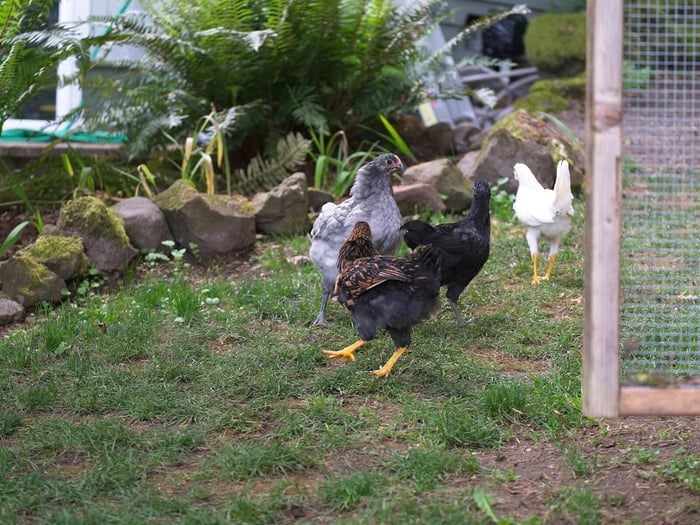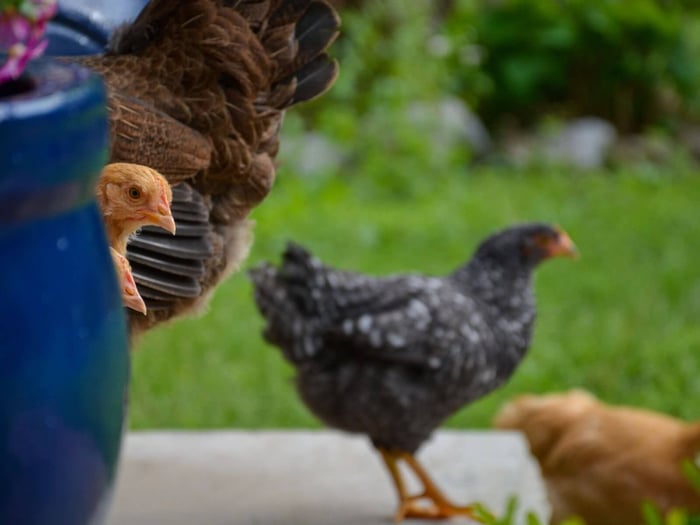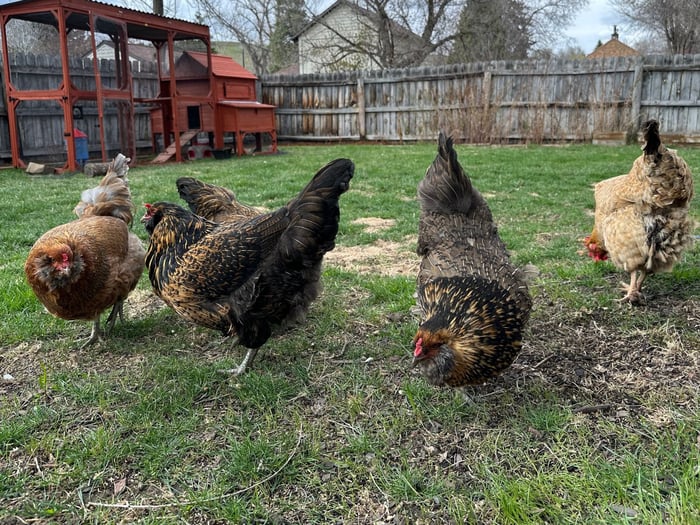Table of Contents
- Introducing Chicks to Your Flock: A Guide for a Smooth Integration
- Step 1: The “Look But Don’t Touch” Method
- Step 2: Integration with Distraction
- Step 3: Integration with Treats
- Step 4: Letting the Pecking Order Happen (As Hard As It May Be)
- How Long Does It Take?
- Bonus Tips for Success
- Final Thoughts
- FAQs
Introducing Chicks to Your Flock: A Guide for a Smooth Integration
Raising baby chicks is one of the most rewarding parts of keeping backyard chickens. But once those adorable fluff balls start outgrowing their brooder, a big question looms: How do you introduce chicks to your existing flock without chaos breaking loose?
The process of introducing chicks to your flock takes time, patience, and a bit of strategy to keep everyone safe and minimize stress. By following a gradual, structured integration plan, you’ll help your chicks and adult hens adjust to each other—without feathers flying.
In this Mother’s Day gift guide for chicken moms (and all chicken lovers), we’ll walk you through exactly how to do it, covering four key stages:
The “Look But Don’t Touch” method
Integration with distraction (free-ranging)
Integration with treats
Allowing the pecking order to establish
Why Integration Matters
Chickens are flock animals with a natural hierarchy called the pecking order. When new birds are added, it shakes things up—sometimes resulting in pecking, chasing, or bullying. Introducing chicks to your flock the right way reduces aggression, keeps everyone safer, and prevents unnecessary injuries.
The goal is to give your flock time to see, hear, and smell the newcomers before sharing space. Think of it like moving in a new roommate—you’d want an introduction first, not a surprise!
 Step 1: The “Look But Don’t Touch” Method
Step 1: The “Look But Don’t Touch” Method
One of the safest and most effective ways to start introducing chicks to your flock is through a “look but don’t touch” setup.
This method keeps the chicks physically separated but visible to the adult hens. Use a small grow-out pen, dog crate, or even place your new chicks inside your run while the rest of the flock is outside, where they can see the chicks but not reach them.
Why it works:
Adult hens get used to seeing the chicks as part of the environment.
Chicks learn flock dynamics from a safe distance.
Reduces the shock of a sudden introduction.
Plan to keep them separated this way for at least 1-2 weeks. You’ll notice the hens getting less interested in the chicks over time—a sign they’re accepting them as part of the flock. You don’t need to do this all day—start with just 30 minutes to a couple of hours, then return the chicks to their brooder to rest and reset.
Step 2: Integration with Distraction
 Once your chicks are fully feathered and can regulate their body temperatures (usually around 8-12 weeks old), you can move on to supervised free-range integration.
Once your chicks are fully feathered and can regulate their body temperatures (usually around 8-12 weeks old), you can move on to supervised free-range integration.
Choose a day when the hens are already distracted—while they’re free-ranging outside the run is ideal. Open the chick enclosure or bring them to the run and let them mingle in a larger space where there’s room to escape if needed.
Why this works:
Free-ranging provides natural distractions (bugs, grass, dust baths) so hens aren’t focused solely on the chicks.
Gives chicks plenty of room to avoid confrontation.
Establishes shared territory in a neutral space.
Now that your flock has gotten used to seeing the new chicks regularly, you can begin adding them to the coop at night. While the little ones might not figure out the roosting bars right away, the nesting boxes will offer plenty of space and comfort as they settle into their new home. Plus, sleepy hens are far less likely to bother investigating the newcomers!
Step 3: Integration with Treats
 Food is the great equalizer—even among chickens. Introducing chicks to your flock is often smoother when treats are involved.
Food is the great equalizer—even among chickens. Introducing chicks to your flock is often smoother when treats are involved.
During free-range or while the chicks and hens are in the same area it will help ease some tension (and add more distraction) to scatter high-value treats like:
Mealworms
Scratch grains
Fresh veggie scraps
Spread them widely so everyone is busy foraging and not hovering over a single pile. This creates a positive association with the chicks: “Hey, these new kids show up and snacks appear!”
Why it works:
Keeps beaks busy with something besides pecking chicks.
Encourages mingling in a lower-stress environment.
Helps break up dominant behavior by focusing attention on food.
Repeat this step over several days, gradually letting the chicks explore more space alongside the flock.
Step 4: Letting the Pecking Order Happen (As Hard As It May Be)
 Here’s the tough love part of introducing chicks to your flock: you have to let the pecking order happen.
Here’s the tough love part of introducing chicks to your flock: you have to let the pecking order happen.
Even with all the gradual steps above, chickens still need to sort out their hierarchy. You’ll likely see some mild pecking, chasing, or chest bumping as the adult hens assert dominance. As long as it doesn’t escalate to bloody wounds or pinning a chick down and repeatedly attacking, it’s best to let them work it out.
What’s normal:
Quick pecks
Short chasing
Fluffed feathers or posturing
🚩 What’s NOT okay:
Ganging up with multiple hens attacking one chick
Severe injuries or blood
Trapping chicks in corners
If things get too rough, separate the chicks again and retry the integration the next day. Some flocks take longer than others, depending on the personalities involved.
Over time, the pecking order will settle, and your flock will become a cohesive unit.
How Long Does It Take?
Introducing chicks to your flock can take anywhere from a few weeks to over a month depending on flock size, age differences, and temperament. The slower you go, the safer and smoother it will be.
Patience is key—resist the urge to rush things just because the chicks seem eager to join!
Bonus Tips for Success
Never introduce tiny chicks directly to full-grown hens. Wait until they’re feathered and closer in size.
Provide extra hiding spots (like logs or crates) in the run so chicks can escape if needed.
Introduce multiple chicks at once rather than a single chick to reduce targeting.
Avoid integrating chicks with a broody hen, as she may act more aggressively to protect her nest.
Final Thoughts
Introducing chicks to your flock is a delicate dance between protection and patience. By following the “look but don’t touch” method, introducing with distraction, rewarding the flock with treats, and allowing the natural pecking order to establish, you’ll set everyone up for success.
And remember: even if things look rough at first, most flocks adjust beautifully over time. Soon, those little chicks will be roosting right alongside their older sisters!
FAQs
When can I start introducing chicks to my flock?
Once chicks are fully feathered and around 8-12 weeks old, they’re ready to start integration with adult hens.
Can I introduce just one chick to my flock?
It’s better to introduce at least 2-3 chicks at a time so they aren’t singled out by the pecking order.
How long should I keep chicks separated before letting them join the flock?
Keep them in a “look but don’t touch” setup for 1-2 weeks minimum before starting supervised integration
What if my hens are still attacking the chicks?
Slow down the process. Try more time in the separate pen or more sessions with treats and free-ranging together under supervision.
Can I integrate chicks with a rooster in the flock?
Yes, but watch carefully—some roosters are protective while others may show dominance. Always supervise initial interactions.


.png)


